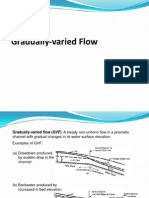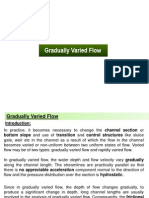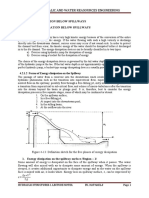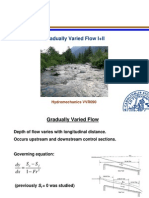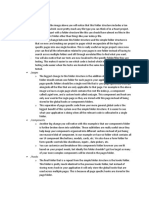Chapt. 4 Edited
Uploaded by
samuelhailu853Chapt. 4 Edited
Uploaded by
samuelhailu853Open Channel Hydraulics Chapter Four
Chapter Two
Gradually Varied Flow (GVF)
Introduction
In uniform flow the cross section through which water flows remains constant. Also the
velocity remains the same, in magnitude and direction. In varied flow the cross section
changes in the flow direction, the water depth changes along the length of the channel.
Varied flow may be either steady or unsteady. Since unsteady uniform flow is rare, the term
"unsteady flow” is used for unsteady varied flow exclusively. Varied flow may be further
classified as either rapidly or gradually varied.
The flow is rapidly varied if the depth changes abruptly over a comparatively short distance;
otherwise, it is gradually varied. A rapidly varied flow is also known as local phenomenon.
Examples are the hydraulic jump and the hydraulic drop. Gradually varied flow is a steady
flow, whose depth varies gradually along the channel.
A steady non-uniform flow in a prismatic channel with gradual changes in its water-surface
elevation is named as gradually-varied flow (GVF). The backwater produced by a dam or
weir across a river and drawdown produced at a sudden drop in a channel are few typical
examples of GVF. In a GVF, the velocity varies along the channel and consequently the bed
slope, water surface slope, and energy line slope will all differ from each other. Regions of
high curvature are excluded in the analysis of this flow.
The two basic assumptions involved in the analysis of GVF are:
1. The pressure distribution at any section is assumed to be hydrostatic. This follows from the
definition of the flow to have a gradually varied water surface. As gradual changes in the
surface curvature give rise to negligible normal accelerations, the departure from the
hydrostatic pressure distribution is negligible.
2. The resistance to flow at any depth is assumed to be given by the corresponding uniform
flow equation, such as the Manning equation, with the condition that the slope term to be
used in the equation is the energy line slope, Se and not the bed slope, S0. Thus, if in a GVF
the depth of flow at any section is y, the energy line slope Se is given by,
Wollega University, Hydraulic and Water Resources Engineering Dpt. . . 1
Open Channel Hydraulics Chapter Four
Where; R = hydraulic radius of the section at depth y
2.1. General Equation for the Gradually-Varied Flow Water Surface Profile
Figure 1: Schematic sketch of GVF
Writing the energy equation,
Wollega University, Hydraulic and Water Resources Engineering Dpt. . . 2
Open Channel Hydraulics Chapter Four
Hence,
𝑑𝑦 −𝑄 2 𝑇 𝑑𝑦
−𝑆𝑓 = −𝑆0 + +( )
𝑑𝑥 𝑔𝐴3 𝑑𝑥
𝑑𝑦 𝑆0 −𝑆𝑓
= 𝑄2 𝑇
…………………….. (1)
𝑑𝑥 1−
𝑔𝐴3
Basic differential equation of the water surface profile for the GVF and also known as
dynamic equation of GVF.
𝑄2 𝑇
Since, 𝑔𝐴3 = 𝐹𝑟 2 the above equation can be written as:
𝑑𝑦 𝑆0 −𝑆
= 1−𝐹 𝑓2 …………………….. (2)
𝑑𝑥 𝑟
The equation (dy/dx) gives the variation of water depth along the channel in the flow
direction or the slope of the water surface relative to the channel bottom. For example: If
dy/dx is positive, the depth is increasing in downstream direction (x) but, if the value is
negative it shows as the depth is decreasing in the direction of flow.
2.2 Classification of Flow Surface Profiles
For a given channel with a known Q = Discharge, n = Manning coefficient, and S0 = Channel
bed slope, yc = critical water depth and y0 = uniform (normal) flow depth can be computed.
There are three possible relations between y0 and yc as:
1. y0>yc,
2. y0<yc
3. y0 = yc
Further, there are two cases where y0 does not exist i.e. When
a) The channel bed is horizontal and
b) The channel bed has an adverse slope
Based on the information given above, the channels are classified into five categories as
indicated in table below.
Wollega University, Hydraulic and Water Resources Engineering Dpt. . . 3
Open Channel Hydraulics Chapter Four
Table 1: Classification of channels
For each of the five categories of channels, lines representing the critical depth (yc) and
normal depth (y0) (if it exists) can be drawn in the longitudinal section. These would divide
the whole flow space into three regions as:
Region 1: Space above the topmost line,
Region 2: Space between top line and the next lower line,
Region 3: Space between the second line and the bed.
Wollega University, Hydraulic and Water Resources Engineering Dpt. . . 4
Open Channel Hydraulics Chapter Four
Figure 2: Regions of Flow Profiles
Depending upon the channel category and region of flow, the water surface profiles will have
characteristics shapes. Whether a given GVF profile will have an increasing or decreasing
water depth in the direction of flow will depend upon the term dy/dx being positive or
negative.
For a given Q, n, and S0 at a channel,
y0 = Uniform flow depth,
yc = Critical flow depth,
y = Non-uniform flow depth.
The depth y is measured vertically from the channel bottom; the slope of the water surface
dy/dx is relative to this channel bottom. Figure below is basic to the prediction of surface
profiles from analysis of the above equation.
Wollega University, Hydraulic and Water Resources Engineering Dpt. . . 5
Open Channel Hydraulics Chapter Four
dy/dxis positive if:
i. If both the numerator and denominator are greater than zero at the same time
ii. If both are less than zero at the same time.
Figure 3: Surface profiles
To assist in the determination of flow profiles in various regions, the behavior of dy/dx at
certain key depths is noted by studying equation below as follows:
𝑦 > 𝑦𝑐 → 𝐹𝑟 < 1
𝑦 = 𝑦𝑐 → 𝐹𝑟 = 1
𝑦 < 𝑦𝑐 → 𝐹𝑟 > 1
And also
𝑦 > 𝑦0 → 𝑆𝑒 < 𝑆0
𝑦 = 𝑦0 → 𝑆𝑒 = 𝑆0
𝑦 < 𝑦0 → 𝑆𝑒 > 𝑆0
Wollega University, Hydraulic and Water Resources Engineering Dpt. . . 6
Open Channel Hydraulics Chapter Four
1. As 𝑦 → 𝑦0 , 𝑣 → 𝑣0 , 𝑆𝑓 = 𝑆0
𝑑𝑦 𝑆0 − 𝑆𝑓
lim = =0
𝑦→𝑦0 𝑑𝑥 1 − 𝐹𝑟 2
The water surface approaches the normal depth asymptotically.
2. As 𝑦 → 𝑦𝑐 , 𝐹𝑟 2 = 1, 1 − 𝐹𝑟 2 = 0
𝑑𝑦 𝑆0 − 𝑆𝑓 𝑆0 − 𝑆𝑓
lim = = =∞
𝑦→𝑦𝑐 𝑑𝑥 1 − 𝐹𝑟 2 0
The water surface meets the critical depth line vertically.
3. As 𝑦 → ∞, 𝑣 = 0 → 𝐹𝑟 = 0 → 𝑆𝑓 → 0
𝑑𝑦 𝑆0 − 𝑆𝑓 𝑆0
lim = = = 𝑆0
𝑦→∞ 𝑑𝑥 1 − 𝐹𝑟 2 1
The water surface meets a very large depth as a horizontal asymptote.
Based on this information, the various possible gradually varied flow profiles are grouped
into twelve types (Table 2).
Wollega University, Hydraulic and Water Resources Engineering Dpt. . . 7
Open Channel Hydraulics Chapter Four
Table 2: Gradually Varied Flow profiles
2.2.1 Water Surface Profiles
M – Curves
Figure 4: General shapes of M curves
From the above M curves asymptotic behaviors of each curve will be examined
mathematically.
a. M1 – Curve
Water surface will be in Region1 for a mild slope channel and the flow is obviously
subcritical.
Wollega University, Hydraulic and Water Resources Engineering Dpt. . . 8
Open Channel Hydraulics Chapter Four
Sf< S0 → Mild slope channel
y0>yc → Subcritical flow
Asymptotic behavior of the water surface is;
Water depth can be between (∞ > y >yo) for Region 1. The asymptotic behaviors of the water
surface for the limit values (∞, yo) are;
a. y → ∞ , V → 0, Fr → 0, (1 – Fr2) = 1
y → ∞ , V → 0, Sf →0
The water surface meets a very large depth as a horizontal asymptote.
The water surface approaches the normal depth asymptotically.
The most common of all GVF profiles is the M1 type, which is a subcritical flow condition.
Obstructions to flow, such as weirs, dams, control structures and natural features, such as
bends, produce M1 backwater curves (see figure below). These extend to several kilometers
upstream before merging with the normal depth.
Wollega University, Hydraulic and Water Resources Engineering Dpt. . . 9
Open Channel Hydraulics Chapter Four
Figure 5: M1 Profile
b. M2 – Curve
Water surface will be in region 2 for a mild slope channel and the flow is obviously
subcritical.
The M2 profiles occur at a sudden drop of the channel, at constriction type of transitions and
at the canal outlet into pools (see figure below).
Wollega University, Hydraulic and Water Resources Engineering Dpt. . . 10
Open Channel Hydraulics Chapter Four
Figure 6: M2 Profile
c. M3 – Curve
Water surface will be in region 3 for a mild slope channel and the flow is obviously
subcritical.
Where a supercritical stream enters a mild slope channel, M3 type of profile occurs. The flow
leading from a spillway or a sluice gate to a mild slope forms a typical example (See figure
below). The beginning of the M3 curve is usually followed by a small stretch of rapidly
varied flow and the downstream is generally terminated by a hydraulic jump. Compared to
M1 and M2 profiles, M3 curves are of relatively short length.
Wollega University, Hydraulic and Water Resources Engineering Dpt. . . 11
Open Channel Hydraulics Chapter Four
Figure 7: M3 Profile
S – Curves
Figure 8: General shapes of S curves
Asymptotic behaviors of each curve will be examined mathematically following the same
step as that of M - Curves.
a) S1 – Curve
Water surface will be in region 1 for a steep slope channel and the flow is obviously
supercritical. (Water depth will increase in the flow direction).
Wollega University, Hydraulic and Water Resources Engineering Dpt. . . 12
Open Channel Hydraulics Chapter Four
Figure 9: S1 Profile
The S1 profile is produced when the flow from a steep channel is terminated by a deep pool
created by an obstruction, such as a weir or dam. At the beginning of the curve, the flow
changes from the normal depth (supercritical flow) to subcritical flow through a hydraulic
jump. The profiles extend downstream with a positive water slope to reach a horizontal
asymptote at the pool elevation.
b) S2 – Curve
Water surface will be in region 2 for a steep slope channel and the flow is supercritical.
(Water depth will decrease in the flow direction)
Profiles of the S2 type occur at the entrance region of a steep channel leading from a reservoir
and at a brake of grade from mild slopes to steep slope (see figure below). Generally, S2
profiles are short of length.
Figure 10: S2 Profile
c) S3 – Curve
Water surface will be in region 3 for a steep slope channel and the flow is supercritical.
(Water depth will increase in the flow direction).
Wollega University, Hydraulic and Water Resources Engineering Dpt. . . 13
Open Channel Hydraulics Chapter Four
Figure 11: S3 Profile
Free flow from a sluice gate with a steep slope on its downstream is of the S 3 type. The S3
curve also results when a flow exists from a steeper slope to a less steep slope (See both
figures).
C – Curves
General shapes of C curves are given in figure below. Asymptotic behaviors of each curve
will be examined mathematically. Since the flow is at critical stage, y0 = yc, there is no region
2.
Figure 12: General shapes of C curves
H- Curves
Wollega University, Hydraulic and Water Resources Engineering Dpt. . . 14
Open Channel Hydraulics Chapter Four
General shapes of H curves are given in figure below for horizontal slope channels; uniform
flow depth y0 does not exist. Critical water depth can be computed for a given discharge Q
and therefore critical water depth line can be drawn. Since there is no uniform water depth
y0, region 1 does not exist.
Figure 13: General shapes of H curves
Figure 14: H3-Profile
A horizontal channel can be considered as the lower limit reached by a mild slope as its bed
slope becomes flatter. The H2 and H3 profiles are similar to M2 and M3 profiles respectively
(see figure above). However, the H2 curve has a horizontal asymptote.
A– Curves
General shapes of A curves are given in figure below. For adverse slope channels, uniform
flow depth y0 does not exist. Critical water depth can be computed for a given discharge Q
and therefore critical water depth line can be drawn. Since there is no uniform water depth y0,
region1 does not exist as well as in A curves. A2 and A3 curves are similar to H2 and H3
curves respectively.
Wollega University, Hydraulic and Water Resources Engineering Dpt. . . 15
Open Channel Hydraulics Chapter Four
Figure 15: A- Profile
Wollega University, Hydraulic and Water Resources Engineering Dpt. . . 16
Open Channel Hydraulics Chapter Four
Figure 16: Profiles of gradually varied flow in a long prismatic channel with a break in
bottom slope
Control Sections
A control section is defined as a section in which a fixed relationship exists between the
discharge and depth of flow. Weirs, spillways, sluice gates are some typical examples of
structures which give rise to control sections. The critical depth is also a control point.
However, it is effective in a flow profile which changes from subcritical to supercritical flow.
In the reverse case of transition from supercritical flow to subcritical flow, a hydraulic jump
is usually formed bypassing the critical depth as a control point. Any GVF profile will have
at least one control section.
Wollega University, Hydraulic and Water Resources Engineering Dpt. . . 17
Open Channel Hydraulics Chapter Four
2.3 Gradually Varied Flow Computations
A computation of GVF profile is very important. Some practical examples are:
a. Determinations of the effect of hydraulic structures on the channels;
b. Inundation, floating of loads due to dam or weir construction;
c. Estimation of flood zones.
There are three approaches for computations of water surface curves (profiles) in GVF
profiles. These are:
1. The direct step method
2.Graphicalmethods direct integration method
3. Standard Step Method
1. The Direct Step Method (Distance from Depth)
The direct step method is a simple method applicable to prismatic channels. Depths of flow
are specified and the distances between successive depths are calculated. The equation may
be used to determine directly (with means explicit) the distance between given differences of
depth (∆𝑦). The equation may be rewritten in finite difference form as:
The equation can also be written as:
Es is the specific energy. In the computation Sf is calculated for the depths y1 and y2 and the
average is taken, which is denoted by Sfm.
For the computations the following data are needed:
Discharge Q
Depth of flow y
Area A
Hydraulic radius R
Roughness coefficient n or C
Carioles coefficient 𝛼
Wollega University, Hydraulic and Water Resources Engineering Dpt. . . 18
Open Channel Hydraulics Chapter Four
Figure 17: The Channel Reach for derivation of direct step method
2. Graphical Integration Method
Consider two channel sections at distance x1 and x2 and with corresponding depths of flow y1
and y2. The distance along the channel is x. If a graph of y against f(y) is plotted, then the
area under the curve is equivalent to X. The value of the function f(y) may be found by
substitution of A, P, So and Sf for various values of y and for a given Q. Hence, the distance
X between the given depths (y1 and y2) may be calculated (numerical integration) or
measured (graphical integration).
This method integrates the equation of gradually varied flow by a numerical procedure.
By this method the largest errors are found in the area with the strongest curvature. This is
the region near the control point(s). The accuracy can be improved by varying the steps ∆X as
a function of the curvature. This method has broad application. It applies to flow in prismatic
as well as non-prismatic channels of any shape and slope. The procedure is straightforward
and easy to follow. It may become very laborious when applied to actual field problems.
Wollega University, Hydraulic and Water Resources Engineering Dpt. . . 19
Open Channel Hydraulics Chapter Four
3. Standard Step Method
The standard step method is carried out step by step from station to station. The distance
between the stations is given, and the procedure is to determine the depth of flow at the
stations. The computation procedure is usually carried out by trial and error. For the
computation the following data are needed:
Discharge Q
Length of the reach
Area A as function of y
Hydraulic radius R as function of y
Roughness coefficient ( n or C)
Carioles coefficient 𝛼
The total heads at the two end sections are:
1. Prismatic Cannels
2. Natural Channels
𝑣2
𝐸𝑠 = −𝑆𝑓 ∗ ∆𝑥 ± 𝛼 2𝑔
Z = stage, level of water surface above datum in m
Compare E2-2 and E2-1; if the difference is not within prescribed limits (e.g. 0.01m),
Re-estimate Z2 and repeat until agreement is reached.
The computation of the flow profile by the standard step method is arranged in tabular form.
Wollega University, Hydraulic and Water Resources Engineering Dpt. . . 20
You might also like
- Backwater Curves & Hydraulic Jump by ChamaraNo ratings yetBackwater Curves & Hydraulic Jump by Chamara10 pages
- Handbook of Sustainable Concrete and Industrial Waste ManagementNo ratings yetHandbook of Sustainable Concrete and Industrial Waste Management6 pages
- Module-3 Association Analysis: Data Mining Association Analysis: Basic Concepts and AlgorithmsNo ratings yetModule-3 Association Analysis: Data Mining Association Analysis: Basic Concepts and Algorithms34 pages
- Coding Club Level 3 Python Building Big Apps PDF100% (1)Coding Club Level 3 Python Building Big Apps PDF134 pages
- Characteristics of Flow Profiles in Open Channel Hydraulics 3No ratings yetCharacteristics of Flow Profiles in Open Channel Hydraulics 338 pages
- Gradually Varied Flow: DR Edwin K. KandaNo ratings yetGradually Varied Flow: DR Edwin K. Kanda23 pages
- Lecturenote - 1273258938open Channel Hydraulics Chapter FourNo ratings yetLecturenote - 1273258938open Channel Hydraulics Chapter Four26 pages
- UGNA2073 Open Channel Hydraulics GVF - (Gradually Varied Flow)No ratings yetUGNA2073 Open Channel Hydraulics GVF - (Gradually Varied Flow)31 pages
- Analytical Solution To Problems Os Hydraulic Jump in Horizontal Triangular ChannelsNo ratings yetAnalytical Solution To Problems Os Hydraulic Jump in Horizontal Triangular Channels4 pages
- Ju, Jit, Hydralic and Water Reasources Engineering: Energy Dissipation Below Spillways Energy Dissipation Below SpillwaysNo ratings yetJu, Jit, Hydralic and Water Reasources Engineering: Energy Dissipation Below Spillways Energy Dissipation Below Spillways14 pages
- Hydraulic Engineering: Course Instructor: Engr. Arif Asghar GopangNo ratings yetHydraulic Engineering: Course Instructor: Engr. Arif Asghar Gopang20 pages
- Gradually Varied Flow and Rapidly Varied FlowNo ratings yetGradually Varied Flow and Rapidly Varied Flow3 pages
- Dymamics of Fluid Flow: Uniform Depth Open Channel FlowNo ratings yetDymamics of Fluid Flow: Uniform Depth Open Channel Flow10 pages
- Chapter 1:types of Flow in Open ChannelNo ratings yetChapter 1:types of Flow in Open Channel61 pages
- Navigation & Voyage Planning Companions: Navigation, Nautical Calculation & Passage Planning CompanionsFrom EverandNavigation & Voyage Planning Companions: Navigation, Nautical Calculation & Passage Planning CompanionsNo ratings yet
- The Mechanics of Water-Wheels - A Guide to the Physics at Work in Water-Wheels with a Horizontal AxisFrom EverandThe Mechanics of Water-Wheels - A Guide to the Physics at Work in Water-Wheels with a Horizontal AxisNo ratings yet
- Feynman Lectures Simplified 2C: Electromagnetism: in Relativity & in Dense MatterFrom EverandFeynman Lectures Simplified 2C: Electromagnetism: in Relativity & in Dense MatterNo ratings yet
- Hydrodynamics and Water Quality: Modeling Rivers, Lakes, and EstuariesFrom EverandHydrodynamics and Water Quality: Modeling Rivers, Lakes, and EstuariesNo ratings yet
- Atlas of Structural Geological Interpretation from Seismic ImagesFrom EverandAtlas of Structural Geological Interpretation from Seismic ImagesAchyuta Ayan MisraNo ratings yet
- CSEC - Nutrition Powerpoint Scribd VERSION100% (1)CSEC - Nutrition Powerpoint Scribd VERSION20 pages
- Analysis of Synchronous Generator Internal Insulation Failures100% (2)Analysis of Synchronous Generator Internal Insulation Failures5 pages
- Complete Download Algebraic Topology VIASM 2012 2015 1st Edition H.V. Hưng Nguyễn PDF All Chapters100% (6)Complete Download Algebraic Topology VIASM 2012 2015 1st Edition H.V. Hưng Nguyễn PDF All Chapters62 pages
- Module-2 Notes Biology For Engineers....No ratings yetModule-2 Notes Biology For Engineers....14 pages
- Encyclopedia of Embroidery From The ArabNo ratings yetEncyclopedia of Embroidery From The Arab3 pages
- 3ms All Sequences Lesson Plans Worksheets Tutorial SessionsNo ratings yet3ms All Sequences Lesson Plans Worksheets Tutorial Sessions110 pages
- Handbook of Sustainable Concrete and Industrial Waste ManagementHandbook of Sustainable Concrete and Industrial Waste Management
- Module-3 Association Analysis: Data Mining Association Analysis: Basic Concepts and AlgorithmsModule-3 Association Analysis: Data Mining Association Analysis: Basic Concepts and Algorithms
- Characteristics of Flow Profiles in Open Channel Hydraulics 3Characteristics of Flow Profiles in Open Channel Hydraulics 3
- Lecturenote - 1273258938open Channel Hydraulics Chapter FourLecturenote - 1273258938open Channel Hydraulics Chapter Four
- UGNA2073 Open Channel Hydraulics GVF - (Gradually Varied Flow)UGNA2073 Open Channel Hydraulics GVF - (Gradually Varied Flow)
- Analytical Solution To Problems Os Hydraulic Jump in Horizontal Triangular ChannelsAnalytical Solution To Problems Os Hydraulic Jump in Horizontal Triangular Channels
- Ju, Jit, Hydralic and Water Reasources Engineering: Energy Dissipation Below Spillways Energy Dissipation Below SpillwaysJu, Jit, Hydralic and Water Reasources Engineering: Energy Dissipation Below Spillways Energy Dissipation Below Spillways
- Hydraulic Engineering: Course Instructor: Engr. Arif Asghar GopangHydraulic Engineering: Course Instructor: Engr. Arif Asghar Gopang
- Dymamics of Fluid Flow: Uniform Depth Open Channel FlowDymamics of Fluid Flow: Uniform Depth Open Channel Flow
- Navigation & Voyage Planning Companions: Navigation, Nautical Calculation & Passage Planning CompanionsFrom EverandNavigation & Voyage Planning Companions: Navigation, Nautical Calculation & Passage Planning Companions
- Capillary Flows in Heterogeneous and Random Porous MediaFrom EverandCapillary Flows in Heterogeneous and Random Porous Media
- The Mechanics of Water-Wheels - A Guide to the Physics at Work in Water-Wheels with a Horizontal AxisFrom EverandThe Mechanics of Water-Wheels - A Guide to the Physics at Work in Water-Wheels with a Horizontal Axis
- Feynman Lectures Simplified 2C: Electromagnetism: in Relativity & in Dense MatterFrom EverandFeynman Lectures Simplified 2C: Electromagnetism: in Relativity & in Dense Matter
- Hydrodynamics and Water Quality: Modeling Rivers, Lakes, and EstuariesFrom EverandHydrodynamics and Water Quality: Modeling Rivers, Lakes, and Estuaries
- Atlas of Structural Geological Interpretation from Seismic ImagesFrom EverandAtlas of Structural Geological Interpretation from Seismic Images
- Analysis of Synchronous Generator Internal Insulation FailuresAnalysis of Synchronous Generator Internal Insulation Failures
- Complete Download Algebraic Topology VIASM 2012 2015 1st Edition H.V. Hưng Nguyễn PDF All ChaptersComplete Download Algebraic Topology VIASM 2012 2015 1st Edition H.V. Hưng Nguyễn PDF All Chapters
- 3ms All Sequences Lesson Plans Worksheets Tutorial Sessions3ms All Sequences Lesson Plans Worksheets Tutorial Sessions

















